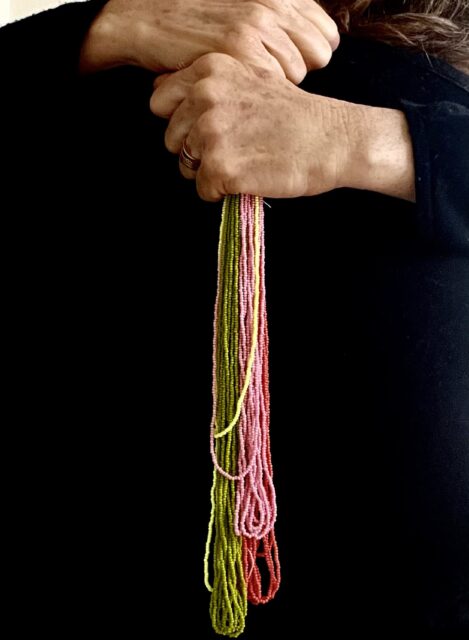
- This event has passed.

Event Details
Artspace
3-378 Aylmer Street NPeterborough, ON K9H 3V8 Canada + Google Map
705-748-3883
View Venue Website
Guest curated by Lori Beavis, ininige examines the work of five contemporary women artists each of whom carry knowledge, memory and skills developed across time and through their art practice. They may be carrying skills learned at a young age, holding the vestige of a love of textiles and patterning from childhood; skills acquired in an academic or group setting; or skills that carry forward from life experience. Each artist is looking backwards and forwards in time – they are relearning and bringing forward material, cultural, and artistic practices, relearning, and teaching these art practices to others –inter-generationally or peer-to-peer. And, they are working in a variety of media as they explore culture, identity, and memory, often as these elements are held in the body.
What does it mean to hold something?
What do we hold from the past that carries us into the future?
The Anishinaabemowin, ininige is a transitive verb meaning, “s/he holds, handles things a certain way; s/he points in a certain direction.” In the English language this word ‘hold’, can be associated as a verb with various adverbs –to hold on, hold to, hold out, hold in – there is also to hold hands, to hold something or someone.
These action words are based in both knowing the past and retaining knowledge/ something for the future. Both are actions that resonates across time. In Anishinaabemowin there is another transitive verb, gashkin or gashkinan that means, ‘to be able to hold, lift, carry it.’
In one of the early stages of thinking through the curatorial thematic for this exhibition – the idea of Indigenous Futurisms was floated. Anishinaabe cultural critic, Grace Dillon first wrote of “Indigenous Futurisms”, in her book, Walking the Clouds: An Anthology of Indigenous Science Fiction (2003). She was actively thinking through perspectives on narrative – in science fiction but also in speculative story-telling and as an imagining of all artistic forms and creativity in order to imagine and visualize all the possible futures for Indigenous people.
From this, there are many ways to consider this genre, but I have come to the idea of Indigenous Futurisms as the way we look to the future – as women, daughters, sisters, mothers, carers, grandmothers by looking both backwards and forward.
I am appreciative of the words of Michi Saagiig Anishinaabe scholar, writer, and author Leanne Betasamosake Simpson, who writes in As We Have Always Done, “The idea of my arms encircling my grandchildren, and their arms embracing their grandchildren is communicated in the Nishinaabeg word, kobade. According to Elder, Edna Manitowabi, kobade is a word we use to refer to our great-grandparents and our great-grandchildren. It means a link in a chain – a link in a chain between generations, between Nations, between states of being, between individuals.”
In this exhibition, these five artists are holding on to one another across generational paths. They are making art that is a transference of influences, knowledge, and techniques. One generation is taking up from the past, holding, building, and carrying into the future.
These five artists – Shelley Niro, Alice Williams, Sandra (Sam) Moore, Dehmin Osawamick Cleland, and Teresa Vander Meer-Chasse – are part of a continuum, some with Artspace itself, and others with the Michi Saagiig territory that Artspace is on and others taking up the mantle of those who have gone before as they move into the future. It is generational and it is a reinforcement of strength.
Shelley Niro and Alice Williams, both established artists, are among the first Indigenous artists to have exhibited at Artspace. In 1997, Niro was one of the artists in Native Love, a group exhibition that the Nation to Nation collective toured across the country. Williams’ textile work has been shown at Artspace, in solo exhibitions, at different points from the late 1990s onwards. Sandra (Sam) Moore is a community-based artist and pedagogue who is responsible in many ways for the revitalization of traditional arts, such as porcupine quillwork, tufting, hide and fish tanning and pine needle work on her home territory. Dehmin Osawamick Cleland is an emerging Anishinaabe-kwe artist whose work while planted in the present looks both to the past and forward to an Indigenous future that is strengthened through sovereignty.
This exhibition brings together artists who each incorporate the knowledges they have been taught. Through their practices they have built relationships that hold them, that they use as a means to carry their knowledge across the generations. They know the histories and have developed strong and sustaining relationships with the land, their materials, and the people. Each artist explores their identity through their own connection to territory, the land, family, stories and history, culture, language/ song, community, and memory. Each in their own way tells stories of reclamation and continuity by looking both backwards and forward to the future.
Regular Visiting Hours
Wed 12 – 4pm
Thu 12 – 4pm
Fri 10am – 4pm
Sat 10am – 4pm
